page 7
http://threesology.org
| What is time pg 1 | What is time pg 2 | What is time pg 3 | What is time pg 4 | What is time pg 5 | What is time pg 6 | What is time pg 7 | Time Travel Considerations |
Stromatolites are the result of mat-building communities of mucilage-secreting micro-organisms that have been on the Earth for billions of years. The key micro-organisms in modern Stromatolites are cyanobacteria. The most common forms of cyanobacteria are string-like (filamentous), ball-shaped (coccoidal), and egg-shaped (ellipsoidal). Hence, we have Linear, Circular, and Triangular forms:
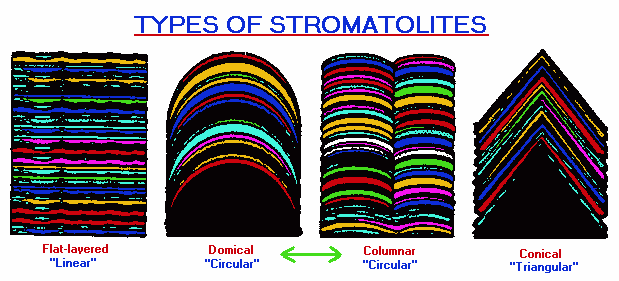
The Domical and Columnar forms are said to grade into one another. The overlapping of these two would thus provide us with 3 types of Stromatolites:
- Flat~
- Domical/Columnar~
- Conical.
If we consider that all forms tend to overlap developmentally, in terms of overall evolutionary processes, then we have a single origin probability.
Along with the above list let us add the following image depicting 3 types of insect development and associating some features as describing a linear, circular and triangular form, though some leaders might want to indicate that the circular and triangular forms appear to blend into one another at different points of development:
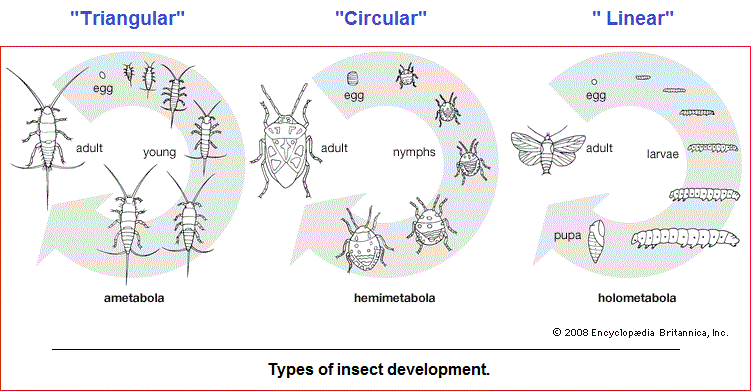
On a level of life with a more complex biological structure and yet still very much in the realm of simplicity, take a look at the following sequence of pictures illustrating a spider at work designing a web. We can recognize the usage of (single) linear, circular, and triangular forms that overlap which display vertical, horizontal and diagonal linkages. While some readers might argue that these are merely basic designs in nature and that there are numerous other examples we could provide, they overlook that this is the very point being made with respect to the Linear ~ Circular ~ Triangular forms. These basic forms, in overlapping succession, may well be the forms characteristic of how consciousness develops.
However, instead of these geometric patterns being used, they may be substituted with other configurations such as numbers, letters, sounds, sights, sensations, etc... An organism, such as humans, that is capable of complex mental activity, will no doubt express such basic forms particularly suited for the human species. A species whose developmental evolution is being subjected to environmental processes of incremental decay creating a situation in which beliefs and world-views are adapted by way of adjusted rationalizations. However, not all human individuals share the same capacity for complexity of thinking. Likewise, different spiders use different "symbols" such as web construction. Some spiders have not developed the ability to construct and utilize such elaborate structures:

Additionally, let us recall the usage of such basic forms on playgrounds in the form of linear monkey bars/see- saws, circular merry-go-rounds, and triangular- shaped slides. (Not to mention the linear/triangular configuration seen while a child is either sitting motionless on a swing, or engaging in the pendulum creations of a triangular illustration when in motion.) A tethered-to-a-pole ball (tether ball) could be viewed as representing a composite of linear, circular, and triangular forms, with the triangle being seen as the angle between tether line and pole when the ball is held out at a distance in preparation for a serve to an opponent player. No less, we can see the linear ~ circular ~ triangular configuration in a lawn sprinkler system to the extent that the connecting pipes are linear, the sprinkler head (in some set-ups) is circular, and the triangle image is seen when the water comes out of the sprinkler head.
Source for above examples: Introduction (to Threesology) page 3c,
with replication produced on this page: Let's Talk Peace page 29.
If time can not be described by any geometric form, perhaps one cares to indulge some wispy, illusory image such as in terms of a supernatural or inexplicable psychic phenomena so that any and all attempts to reach some concrete definitive answer is always to be met with yet another explanation which is meant to defy explanation in human terms other than some wistful staring-into-the-flames adolescent intrigued supposition.
One might also prefer to describe time mathematically, as an extension of the already-in-use numerical sequence from 1 to 12. But in doing so, many readers not well versed in mathematics beyond elementary arithmetic would quickly become lost, no matter how one's ego feels their intelligence is better able to reveal subtleties they presume ordinary words are incapable of providing the nuances of complexity. Then again, we often find those who don't actually think in complex terms but want to surround themselves with people or inanimate objects/rituals which are defined as being an expression of intelligence, and enormously typical of many politicians who represent an average or below average acumen... and this is why they are frequently portrayed in television shows and movies by writers who scripts are battered down to the level of normalcy that many producers are most comfortable with and think they will be able to profit from.
Yet, is time... that is if it exists in an actual state and not just human imagination, a complex phenomena? Even if we were to travel through time and presumed dimensions of time, is it complex... or complex due to an unfamiliarity with a simplicity? Is time little more than a means of describing observations related to life and death or more simply put... change? Is time... change? Can time exist without change? Is time better described as a type of ruler or measuring tape? Or is time a measure of the ruler or tape itself? Is it little more than a conventionalized rule-of-thumb standardized by whatever authoritative declaration sets it in place, regardless if it is merely a tool of convenience that may have little value to considerations of time beyond the confines of the Earth, solar system or galaxy?
In measuring the measure of time in its development, let us reflect on early uses such as perhaps a stick placed into a ground and the observance of its shadow with the passage of the Sun, though the first observations may have involved some observation of an event such as the opening of a flower, presence of an animal or even person occurring at a given spot at or near the same time of day over a period of an acute (and repeated) observational experience. In a later development, we might want to recall the usage of a Sun dial, both of which used a singular or linear object that may have been encircled by stones or number-related symbols which allowed triangular/rectangular shadows to be cast upon the ground or platform. A type of sundial which utilized a person as the stick (sundial gnomon) an a hopscotch type of layout with the different months of the year assigned to different sections, allowed anyone to participate in identifying the time of the day according to the month of the year.
 |
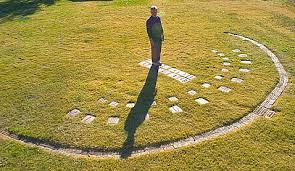 |
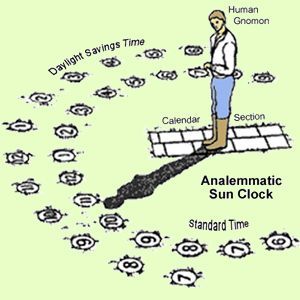 |
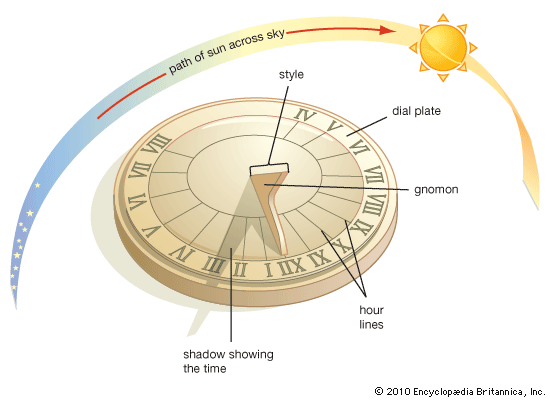
|
Long after the notion of time had been established, it was thought that a type of "flower clock" could be developed based on the opening and closing times displayed by various flowers. Carolus Linnaeus (1707- 1778) proposed such an idea, but it is not know whether he made one or not. The following image is an idealized portrayal of a flower clock.
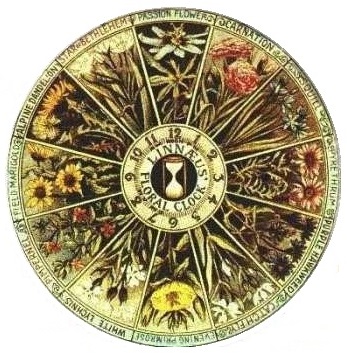
Eventually, with the passage of time, a means of keeping a more accurate measure of time (with respect to our solar environment) was followed by clocks which displayed a minute and hour hand, that was eventually replaced with a three-hand version of seconds, minutes, hours. At present, in many cases, these three have been fused by the usage of electronic controlled digital displays. Hence, we see that the measure of time has itself evolved in our attempts to illustrate greater complexity by using a single, then double, and then a triple-handed model that has now fused these three into a type of singularity. In other words, we see a one, two, three... three-into- one configuration. (The one-handed time pieces such as sundials represented a one-in-one configuration. With the usage of two hands on clocks, this was a two-in-one configuration. With three hands, we now have a three-in-one configuration that remains as such in digital clocks since time measurements typically involve seconds, minutes and hours, though those equipped like stop watches can show other increments of time as well.) However, in my research into the threes phenomena, not all the stages of all one-two-three development may be clearly seen in all examples, and some may in fact be absent due to time and place of observation... not to mention examples where there appears to be a reversal of time to some earlier developmental expression.
| One-handed clock |
Two-handed clock |
Three-handed clock |
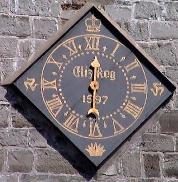 |
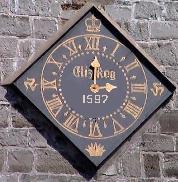 |
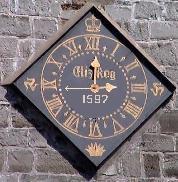 |
The one-handed clock honours Elizabeth I's visit to the Isle of Man. The other two are my own reproductions of a two and three-handed clock that most people today are aware of. (Notice the 3-legged symbols at 3 and 9 O'clock. These two symbols, along with the two different crowns, brings the total to three different border symbols.) |
||
One of the frequently used psychological measurements of time (as opposed to some instrumentation) is related to when we see a lightning flash and the following thunder. Typically, we find those who say that for each second counted, the distance is one mile. However, according to the following charts, this is not the case:
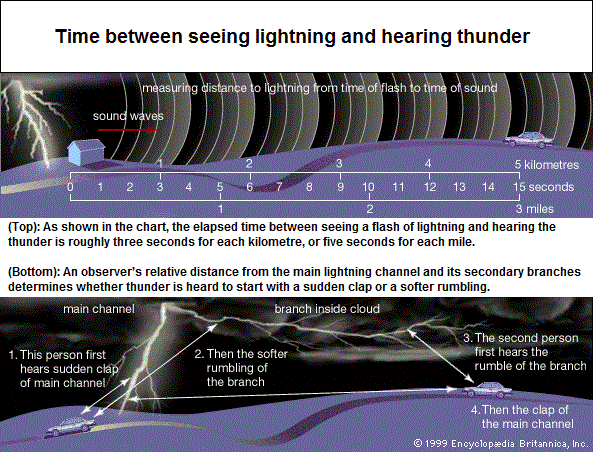
Our concept of time may indeed be a projection of an acknowledgment of biological processes, or even an extension thereof occurring in our brain which may well be developing into a greater functionality... as a response to environmental deteriorations that appear to be directed along a course of decadence. In other words, the development of our concept of time (as a biological architecture) illustrates the same 1,2,3 developmental blueprint sequencing that we see the developmental staging of the Three Germ Layers (Triploblastic: Endoderm/Entoderm/Endoblast- Mesoderm- Ectoderm) discovered from the flatworm to humans, with lesser complex organisms exhibiting a single germ layer (Monoploblastic) like the sponges and slightly more advanced creatures exhibiting two germ layers (Diploblastic: such as the cnidarians [sea anemones, corals, and jellyfish]).

Germ layering and subsequent developments as a representation of time. → → →
If we continue with the idea that biologically has influenced our concept of time, we need to look further back in time to that predating that of the three Germ layers in an attempt to get a sense of what may have been the earliest influence not only of time, but that which may have set a recurring pattern-of-three usage in many subject areas. A step backwards may well lead us into the area of distinguishing three domains of life, though other (alternatively enumerated) models do exist:
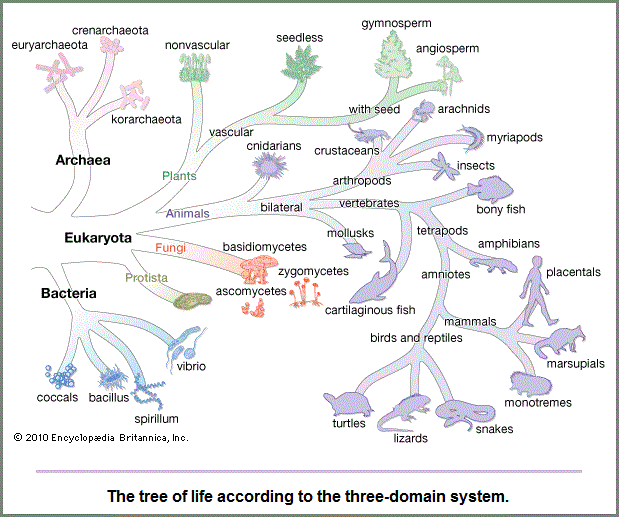
If we attempt a further retrograde from the three domains, we can find an earlier 1,2,3 sequence representation from simplicity to complexity in the lineup of the three main bio-polymers known as DNA, RNA and Proteins. Whereas those arguing for a single stranded "RNA world" precursor, this may be the case if there was no single-stranded DNA or Protein entity. As it stands, we typically describe RNA with one strand, DNA with two strands, and Proteins with a single, double, triple conformation, with the added feature of a quaternary structure as a composite (or fusion) of the first three... even though there remains some controversy over which of the three truly came first.
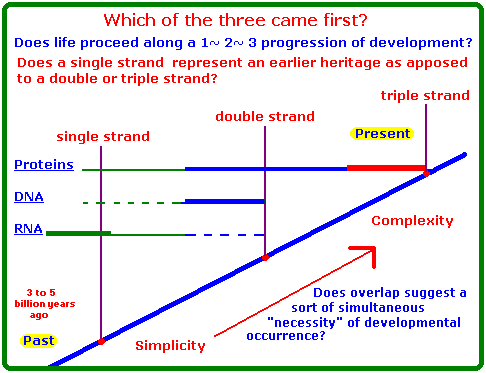
If we attempt to pursue the recognition of a yet earlier influence, we might want to suggest the present existence of the proton-neutron-electron trio of atoms, even though this may one day exhibit a different 3-to-1 ratio formula than it presently does, and that this trio may have at one time been a duality preceded by a singularity in the far distant past. Analogously, one might view these three as differentiated brain sections such as the triune brain complex idea of Paul Maclean (Reptilian brain, Old mammal brain, New Mammal brain), that we can somewhat substitute with the idea of the Reptilian brain, Right Hemisphere, Left Hemisphere, since the Reptilian brain develops first, the right hemisphere develops afterwards... followed by the left hemisphere,
Is the human concept of time a metaphor for human biological processes set into an environment that is decaying and as a means of adapting to the incremental deterioration, we utilize what can be described as "rationalized adjustments" clearly noted in our belief systems which attempt to "smoose" or mollify any detailed realization thereof and therefore develop foolish ideas suggesting perseverance, strength, fortitude, etc., instead of accepting the need for developing a means to get off the planet, away from the solar system, and eventually the galaxy? Is the concept of time a tool of measurement or a metaphorized perception of our place in a given circumstance and can thus be viewed as a type of circadian (and/or shorter/longer term) rhythm? ...And yet the "rhythm" denotes a type of perception which, by application to a given species, describes more of the same self-oriented interest?
What, if anything... is time? Is it an illusion that we have created into a fairytale proportioned with both animate and non-animate objects which have come to be named, but is absent those perceptions which have not acquired a common label, definition or inter-communicated realization? Whereas it can remain in its "simplified" state of usage... however noting that we can imagine primitive peoples of the past having a more rudimentary formula and usage; or we can intellectualize it philosophically to bring other considerations to bear upon a discussion thereof. One such consideration is whether time is in the eye of the beholder like truth, beauty, justice, wealth, obstacle, love, charity, health, etc... Is time moldable in terms of a conceptual model used to explain gravity within the confines of a purported space-time (and its presumed) continuum such as in the case of Einstein's theory of relativity? Is the phenomena of time similar to the phenomena of gravity and the elusive graviton particle?
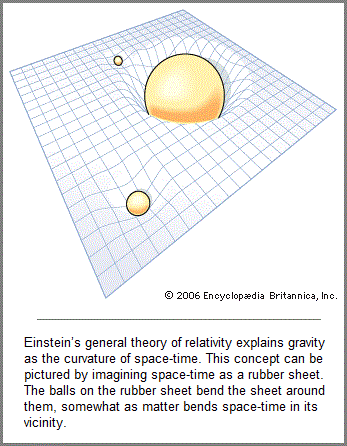
This direction of contemplating time leads us in the direction of wondering whether time itself has a limit such as in a beginning, an end, and how fast or slow it is. Since we at present think that the speed of light is the most calculable measure of time in reference to that which is observable, and that nothing apparently travels faster within this philosophical context of physics, it is necessary for us to provide at least some lip service to this aspect of time, followed by a consideration of time with respect to the expansion of the Universe:
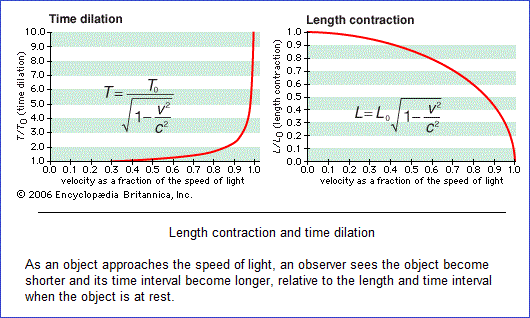
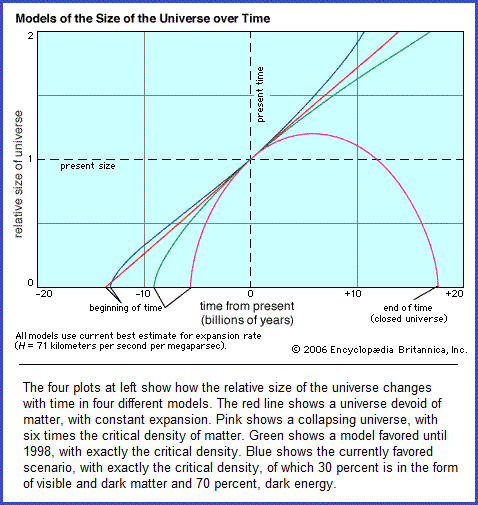
Because it appears that time can be distorted, or at least altered, we consider that not only its shape and size, but also "personality" can be altered from place to place and be perceived differently due to differences in perception. For example, because we can identify and label different positions of the Sun relative to our position, the notion of different time zones (with matched circadian rhythms) is easily understood. Hence, there is the phenomena of "jet lag" experienced by some travelers traveling from one time zone to another, with the distinction of such increased as the time zone difference increases as well.
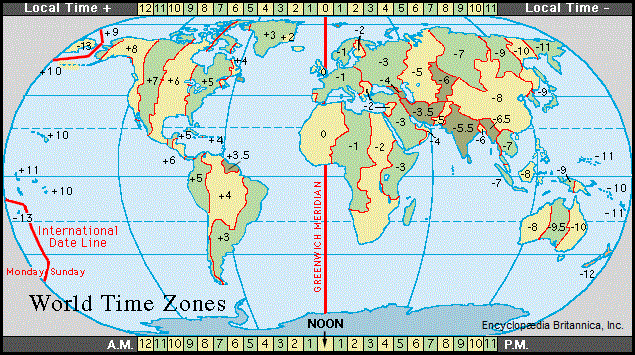
Whereas time may be perceived differently with respect to one's position in relation to solar events, this necessarily does not itself equate with a different type of time. It merely means the same kind of time is perceived earlier or later in terms of one's point of reference in relation to one or more other objects and/or accompanying events. With this in mind, we may denote different kinds of time such as Universe-event time, Geologic time, fruit fly life span time, human life span time, galactic time, lunar time, tidal time, Universal time, standard time, space-time, music time, episodic time, psychological time, etc... Yet, different scales of time do not necessarily mean time is different... it is merely wearing different garments or exhibiting different personalities housed in/over a single body. Granted that our perceptions and measurements of time can reference different options, but the phenomena we presently reference as time does not actually change. Even if we were to encounter a species or non-animate event which exhibits or perceives non-linear time, would a circular, see-saw, triangular, etc,. formula of time be different at its most fundamental core?
If humanity switched from calculating time in terms of numbers and instead used colors such as in the case of the color spectrum, this usage may provide us with different appreciations of time, but this may not mean time itself has been altered. Typically however, when identifying different colors of the visible spectrum, the enumerated references are not being viewed as a sort of clock. Likewise in the case of the larger electro-magnetic spectrum. And even though numbers on a clock are a type of scale, not all scales are used in terms of referencing time differences, even though the usage of different values does require time intervals as part of the assessment... time simply is a value that is taken for granted as an acceptable variable.
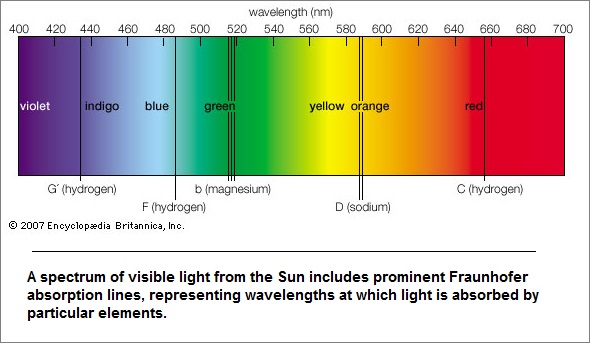 |
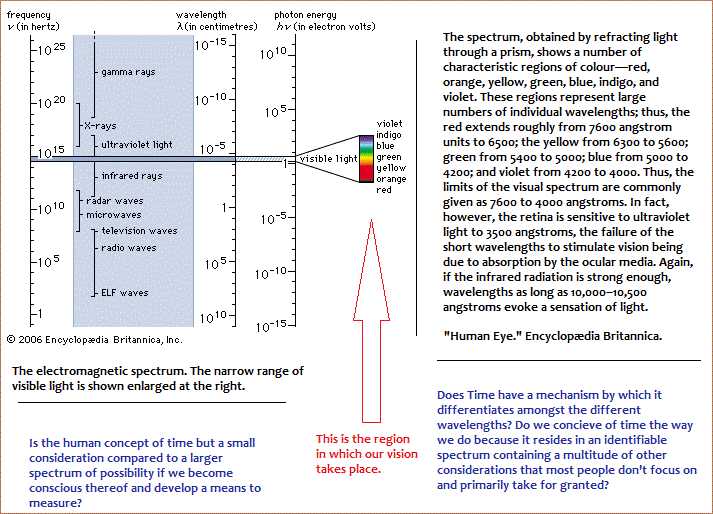 |
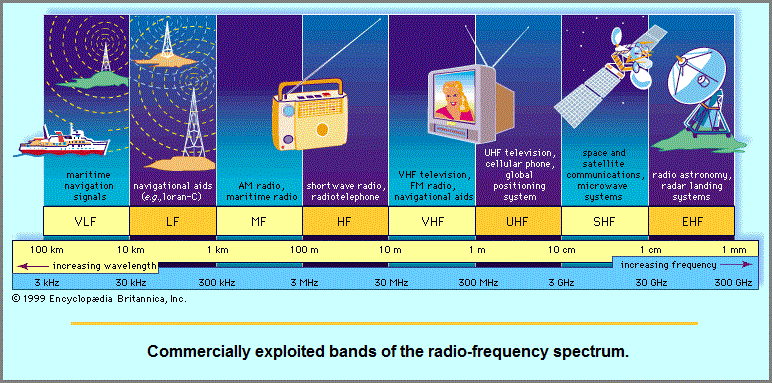
| |
While many calculate time in terms of a beginning to end progress, others use decay... a sort of time reversal process such as in the decay of carbon 14, to calculate age for purposes of distinguishing such things as the age of a civilization, fossil, geological event, etc... Here's a short Britannica article on half-lifes of atomic nuclei:
Half-life in radioactivity, (refers to) the interval of time required for one-half of the atomic nuclei of a radioactive sample to decay (change spontaneously into other nuclear species by emitting particles and energy), or, equivalently, the time interval required for the number of disintegrations per second of a radioactive material to decrease by one-half. The radioactive isotope cobalt-60, which is used for radiotherapy, has, for example, a half-life of 5.26 years. Thus after that interval, a sample originally containing 8 g of cobalt-60 would contain only 4 g of cobalt-60 and would emit only half as much radiation. After another interval of 5.26 years, the sample would contain only 2 g of cobalt-60. Neither the volume nor the mass of the original sample visibly decreases, however, because the unstable cobalt-60 nuclei decay into stable nickel-60 nuclei, which remain with the still-undecayed cobalt. Half-lives are characteristic properties of the various unstable atomic nuclei and the particular way in which they decay. Alpha and beta decay are generally slower processes than gamma decay. Half-lives for beta decay range upward from one-hundredth of a second and, for alpha decay, upward from about one one-millionth of a second. Half-lives for gamma decay may be too short to measure (around 10-14 second), though a wide range of half-lives for gamma emission has been reported. Reference: "Half-life." Encyclopædia Britannica Ultimate Reference Suite, 2013. |
Nonetheless, regardless of the many models and alternative ideas we might provide to distinguish time as a tool of measurement, have we at all answered "What is time"? If we feel it is sufficient to say that time is a tool by which we measure, is this at all adequate... or only permits us an excuse not to think about it any further? Is time as we represent it, or is our usage but a tip of the iceberg so to speak? Also in our contemplations of time is the notion of time travel... which in a sense, is accomplished from birth to death and is psychologically advanced by the notion of reincarnation to suggest a type of traveling backwards in time. Then again, there are some who exhibit mannerisms and ideas which are clearly better suited for a former time, and might well have prospered in a past, distant age, while those who are more suited for a future time having difficulty with the present so-called "modern" era... which to these futuristic people is quite primitive. From this perspective we might answer the question about what time is by saying that it can be whatever one wishes it to be, even if to others this is thought or felt to be wrong since they measure time in one or more different ways.
Whereas Time may be a singular item or "thing", we do not all perceive it in the same way. By looking at that which many of us come to agree on as being a description of Time, looking at this and other perceptual definitions may or may not lead us to a clearer picture (and utilization) of time from a human perspective, though the word "human" represents varying entities with different acuities of perception. While all of us may become aware of some "thing" we refer to as time in a general way so as to "be on the same page" in order to communicate and interact in some semblance of commonality, this is not to say that that which we are all describing as time, actually is a definitive definition thereof. The preceding illustrations and ideas being related to time, just as one might attempt to do with the subjects of Artificial Intelligence and Peace from a threesological perspective, is simply another way of approaching such entities from different vantage points in an attempt to facilitate a firmer appreciation thereof.
Page initially created: Thursday, 16-Nov-2017... 05:10 AM
Initial Posting: Sunday, 15th-April-2018... 8:20 AM
Updated Posting: Tuesday, 29th-May-2018... 12:08 PM
Herb O. Buckland
herbobuckland@hotmail.com
